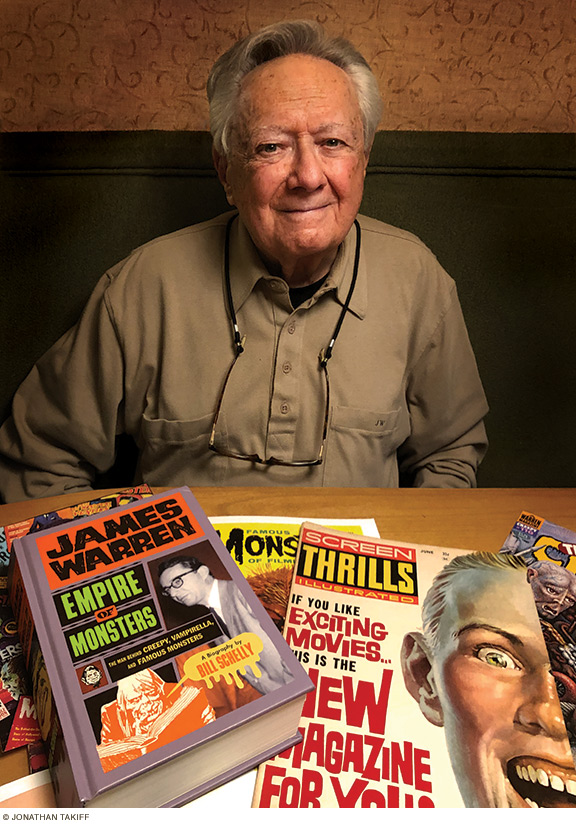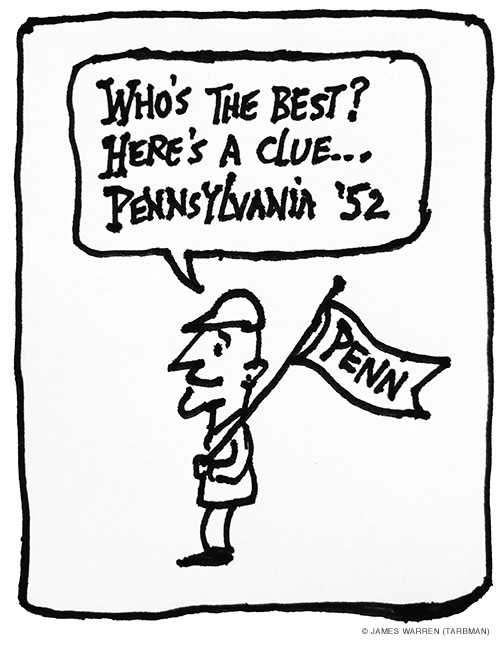
The publisher of 1960s-era horror-comics magazines had—and still has!—a colorful personality to match.
James Warren (Taubman) C’52 still has the gift.
It’s been 35 years since the magazine publisher, editor, and art director had his hand in the business of humor magazines, scary comic books, and entertainment fanzines. But some of the titles he created and nurtured from the late 1950s through the ’80s —Famous Monsters of Filmland, Help!, Creepy, Eerie, and Vampirella among them—are still being published in anthology series.
And cult interest in his work remains strong. The hardback first edition of Bill Schelly’s biography James Warren, Empire of Monsters sold out within weeks of publication last spring and will be available this June in paperback from Fantagraphics Books.
“Hard to believe people still care,” muses a jocular Warren, now almost 90, over cocktails at his favorite Italian restaurant in suburban Philadelphia. Beyond the window, a customized taxi labeled “Warren Cab Company” is parked by the front door. “My second,” he notes. “The first was a custom stretch Checker that I had built for transporting guests visiting my summer beach house in the Hamptons.”
Warren’s swinging playboy side is amply represented in Schelly’s biography, but Warren claims that’s news to him. “I haven’t read it,” he confesses. “The author interviewed people who don’t like me. So I’ve just presumed it’s a hatchet job.”
Not really. By and large, the tome paints Warren as a media innovator who dared to take on the establishment—including cutthroat magazine distributors; larger comic book publishing houses like DC, Marvel, and Archie; and the Comics Code Authority (CCA), an industry-backed censorship organ created in 1954 to battle fearmongers who blamed comic books for causing juvenile delinquency. Warren published his graphic stories in larger, “Time magazine-sized” editions, which kept the mags off the tightly guarded comic book racks and away from CCA scrutiny.
These days, Warren mostly waxes romantically about his “lifelong love” and now 25-year companion. “It’s a great story,” he says. “Gloria Goldberg was my first teenage girlfriend and the physical role model in my head for the Vampirella character. Then she came back and rescued me after a 50-year separation.”
Warren has also played the role of rescuer. He once gave refuge to the original “Gang of Idiots” (Harvey Kurtzman, Will Elder, Wally Wood, and Jack Davis) from Mad magazine at his own start-up Help!—a title that predates and may have inspired, he intimates, the title choice for the second Beatles film. “United Artists denied it was intentional, but we made a deal …”
He also nurtured many young editorial talents who’d go on to make lasting marks on popular culture, including Gloria Steinem, Terry Gilliam, Diane Arbus, Woody Allen, and John Cleese. And he regularly bestowed his most important cover assignments on a future kingpin of science fiction and fantasy illustration—Frank Frazetta.
The sway of the Famous Monsters magazine—often riffing comedically on horror movie stills—was particularly strong on young readers who picked it up in its heyday in the late 1950s and early ’60s while staying up late on weekends to watch Shock Theater TV replays of Frankenstein and Dracula. “Then and now, I could communicate and joke better with 11-year-olds than with people my own age,” Warren says with a grin. “That young age was the happiest time of my life—reading early Superman comics, listening to radio dramas, seeing Flash Gordon serials at the movies on Saturday, starting my first neighborhood newspaper when I was 10.”
Famous Monsters fan club members included Steven Spielberg and George Lucas. Stephen King “sent us a manuscript that got lost in a pile,” Warren says. Lenny Bruce—later a personal pal—“first reached out to our mail order division to purchase all the 8mm versions of monster movies we were selling,” which the comedian would then integrate into his standup routines.

Quite the hands-on guy—which he allows made him “very demanding, difficult to work with”—Warren can still turn out a cute cartoon. Over drinks, he quickly recreates an illustration he first drew as a Penn freshmen in 1948, depicting a typical frosh wearing a goofy beanie hat (see image above). “Back then we called it a ‘dink’ and it was essential wear for a first-year Penn student—both as a matter of self-identification and pride but also intimidation,” he recalls. “Sophomores—vigilante committees—would beat you up if you didn’t wear it.”
A Northwest Philly native known then as James Warren Taubman, he bussed and trolleyed to Penn to study architecture in the School of Fine Arts, “because both my art teacher and advisor at Central High School said it was a practical career for me.” But in truth, Warren found the old school Beaux Arts architectural training program tedious—“forever drawing cathedrals with flying buttresses.” He got more satisfaction from extracurricular activities, landing a far more complex cartoon in Esquire magazine and serving as coxswain for the freshman crew team—“until an oar caught me in the nose, broke it in two.”
Having followed World War II battles as a youngster, Warren joined the ROTC at Penn and hung out with returning war vets who “filled my ears with their combat adventures.” So when the Korean War broke out after his sophomore year, and “being a foolish 20-year-old,” he put his education on hold and enlisted, with the ROTC credit fast-tracking him to officer school. That pipedream went up in smoke six months later when Warren was deafened—“initially 100 percent, later only 50”—by an overdose of close-range heavy mortar fire as he came to the rescue of a panicked new recruit “caught up on barbed wire.”
After an honorable discharge and a long recovery (which included learning to lip read), Warren went back to Penn for another rude awakening. He recalls that the “Beaux Arts curriculum was out,” in favor of a modernist pedagogy that reshaped the department. “I was told I’d have to start all over again as a freshman in this five-year program.”
Chomping at the bit to join the real world, Warren abandoned Penn to start his own advertising agency. Then, at 26, he jumped into the publishing game, initially with a men’s magazine, After Hours, that was “quickly put of business by a headline-seeking Philadelphia district attorney” on charges of obscenity and pornography. Not long after, he launched Famous Monsters of Filmland, the film magazine that became a 25-year hit under his management. It began “with a $1,200 loan from my dad” and later grew into Warren Publishing Company, which regularly issued at least six different branded magazines plus numerous one-off specials.
“Early on, the CEO of the nation’s leading printer of comic books [World Color Press] took a liking to me, after I informed his billing department that we’d been undercharged $35 on a $10,000 printing job,” he says. That led to a $100,000 line of credit.
Not all of his principled acts turned out so well. A convert to the anti-war cause during Vietnam, Warren introduced a war-is-hell themed comic book, Blazing Combat. And he devoted full pages in other Warren magazines to implore readers to “write your Congressman …. to back an act of disengagement…. and if you’re not yet old enough to vote, give this to someone who is.”
That cost him a lot, he says. “Our magazines were banned from Army PX’s, a big part of the comics business. We also ran anti-smoking ads, long before that was fashionable. That hurt us in advertising, too, and killed Blazing Combat after just a few issues.”
And if he had it to do all over again? “Of course I would.”
—Jonathan Takiff C’68


Where is James Warren Taubman now? Is he still alive, is he still working in entertainment, or has he retired for good? We love this man and would like to know where he is and where he can be contacted. Please let us know. Thank you!
James Warren allowed me to experience a large amount of fantastic writers and artists during my formative years and I thank him for it everyday…he was and is a huge influence on my life!
Thank you sir!
Wondering if he is associated with or does he endorse the “Warrent” homage publication “The Creeps”?
All the best.
Wish Warren would tell the real truth and story of Eerie #1 (2nd Print) counterfeits. This fans would love the know what he knows about them.
I loved Famous Monsters. There was no cable back then so when a movie that FJA wrote about in FM came up in the tv listings, I HAD to make a point of watching it, regardless of the time it aired; we had only 4 stations.